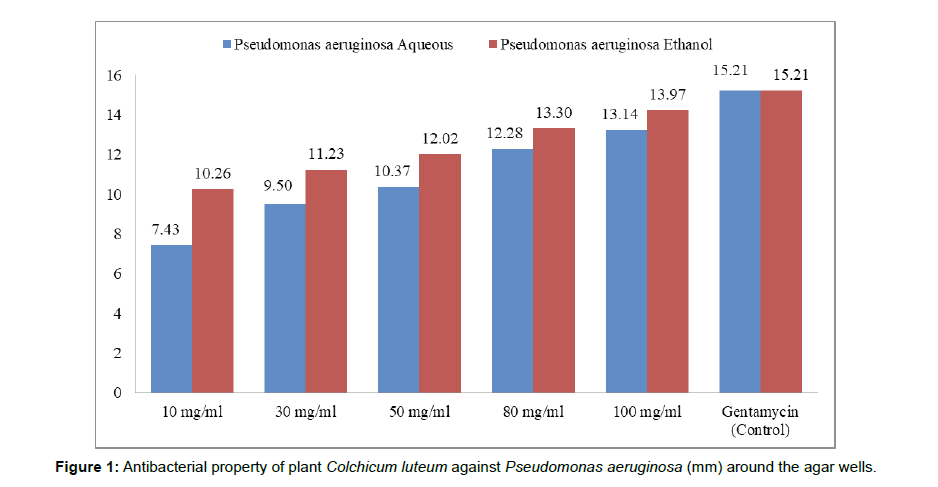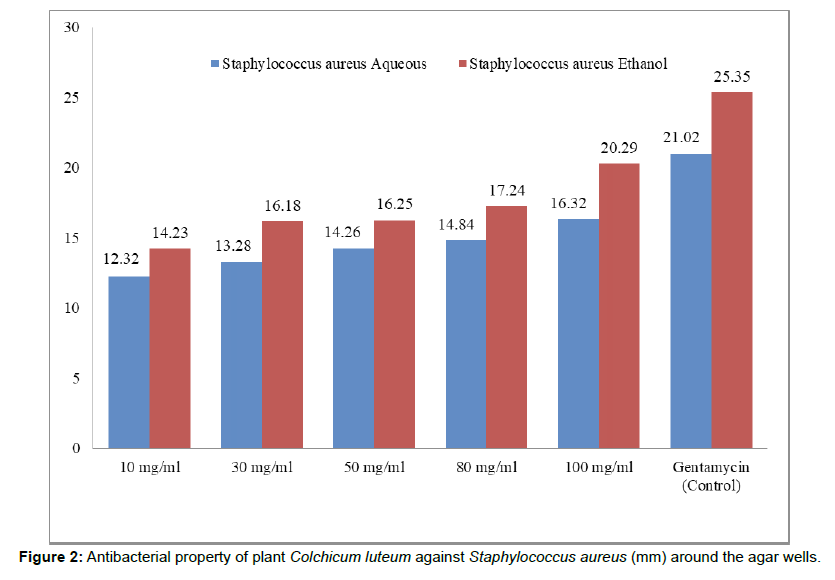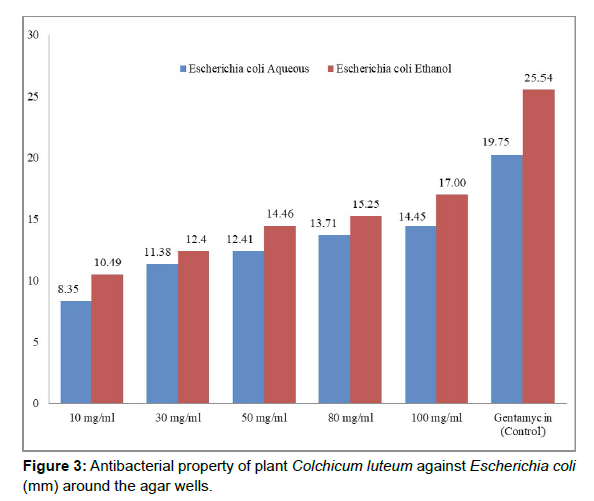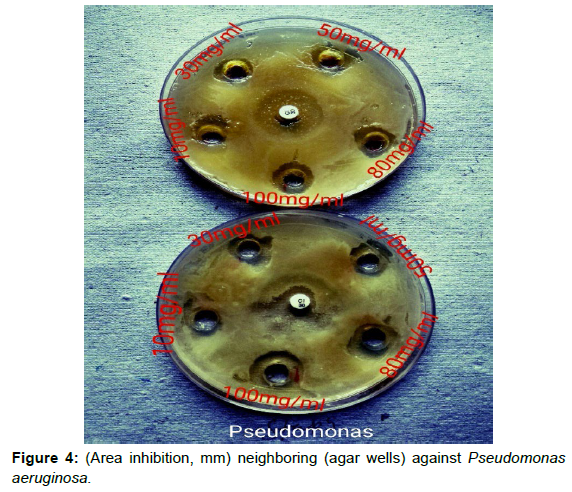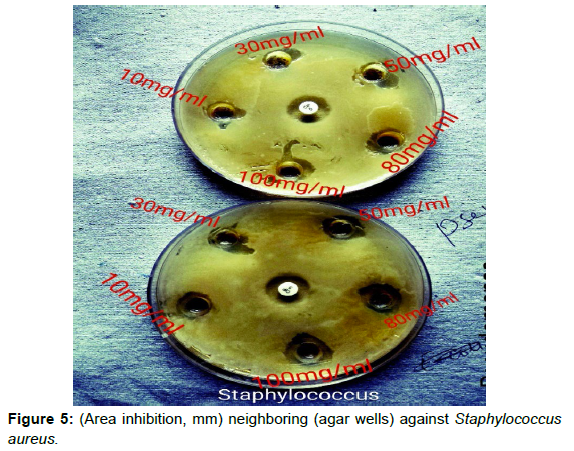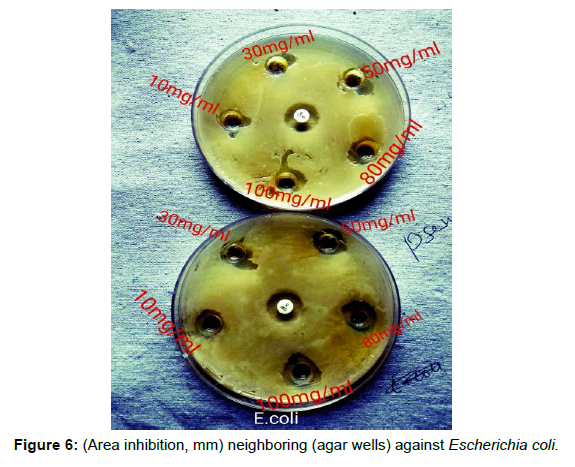Evaluation of Antibacterial Property of Colchicum luetum L. Medicinal Plant of North Western Himalaya
Received: 12-Apr-2022 / Manuscript No. science-22-60476 / Editor assigned: 14-Apr-2022 / PreQC No. science-22-60476 (PQ) / Reviewed: 17-Sep-2022 / QC No. science-22-60476 / Revised: 23-Sep-2022 / Manuscript No. science-22-60476 (R) / Published Date: 30-Sep-2022 DOI: 10.4172/science.1000133
Abstract
The current study examines the antimicrobial potential of aqueous and ethanolic extracts derived from Colchicum luetum Baker, medicinal plant with numerous medicinal effects. The bacteria’s selected viz. Staphylococcus aureus,Pseudomonas aeruginosa and Escherichia coli.Five differential combinations i.e.,(10,30,50,80 and 100 mg ml-1)about the two aqueous and ethanolic extracts of Colchicum luetum act used in contrast to the mentioned above bacterial strains.Ethanolic extract demonstrate significantly high antibacterial action across Pseudomonas aeruginosa,Staphylococcus aureus also Escherichia coli; alongside area about resistance (14±0.27 mm),(20±0.27 mm) and (17±0.14 mm) by 100 mg/ml.The research windup certain herb grab innovative admixture amidst important antibacterial properties. Desolation along with characterizing about these innovative compounds keep administer strong animicable worker,thus counteracting disease causing organisms.The findings indicate the potential use of extracts from the plant to develop new organic antibacterial products.It’s corms and seeds could be a natural source for the pharmaceutical industry Therefore, pharmaceutical Industries can manufacture the drugs against these bacterial diseases.
Keywords
Antimicrobial, Colchicum luetum; Zone of Inhibition; Aqueous and Ethanolic; Himaliya
Introduction
Medicinal herbs abide generally used in medicinal production as manufactory about loaded antibiotics also appropriated in the design of fresh herbs by local population [1-5]. Herbal medicines also treated as medium as well as equitable sources for better and healthy life. These herbs having large curative significance [6-9]. Broad diversity of commonly employed antibiotics gathered together in large quantity in natural left out part of management [10-12]. This is very important to collect these resources with experience as well as responsibility to manage its continuing existence. Due to anthropogenic activities, thus these beneficial sources become scarce on earth. Worldwide there are about 10,000 herbaceous (medicinal) plant species which are venerable, due to various anthropogenic and natural activities on endangered Medicinal Plant Species of North Western Himalaya [12-19].
“Colchicum luteum Baker, generally called as (Suranjan-e-Talkh, Urdu) [20]”. The genus Colchicum comes under family Liliaceae or Colchicaceae. Their “species” account continuously change about (100) types of species of Colchicum are dispersed unevenly across the world [21]. In the colchicum, “31picular types alkaloids has been confined” [22]. Important compound colchicine obtained from Colchicum luetum, which helps to cure against “Behcet’s syndrome” [23,24]. Alkaloid “Colchicine” is the major chemical compound derived from “Colchicum genera”, [25-29]. Alzheimer disease (AD) is cured by the drugs antiinflammatory obtained from plant corms of C. luteum [21, 30-32]. The species is facing various biotic stresses like uncontrolled grazing, illegal harvesting, deforestation, loss of habitat, construction of roads and tourist impacts etc., [19,33].
Human population is mostly get effected by contagious microbial population from old times and memorable till date. Microbial species viz. “Pseudomonas aeruginosa, Klebsiella pneumonia, and Escherichia coli” causing dermis infection, septic infection, upper as well as respiratory infection [34-37]. Escherichia coli cause genealogical diseases and infections. “Staphylococcus aureus causes intra intestinal infection, bone as well as joint effects, below respiration infection and dermis diseases” [38-40]. Thus herbal plant species were the earlier targeted weapon employed humans to cure pathogenic diseases .The Inauguration of antibiotics came in the existence in (20th) century [41,42]. Thus, in that surely to flourish different ant infectious medicines to cure various infection causes illness, first path be about to cover regional “medicinal plant her for potentional antimicrobial properties”. These herbal ingredients persist an essential natural recourses to fight against severe illness disease, through worldwide [43-46]. World Health Organization WHO 1993 reported (80%) world’s human life mainly vulnerable on the conventional medicines as well as main item of the “traditional therapies” associate to apply the these herbal extract either their effective/active compounds. Still an experimental scientific investigation of plant to resolve their “antimicrobial effective constituents is a comparatively advanced field” [47].
Material and Methods
Collection and identification
Corms of the plant Colchicum luteum and samplings gathered from the selected areas of Kashmir Himalaya in the onset set of March -April (2017-2018), and the identification were done at Division of Environmental Sciences, SKUAST-K Shalimar, Srinagar and verified by Dr. Haleema Bano (Assistant Professor Skuast-k). The corm plant samples were “rightly labeled and noted with the date of collection and preserved.”
Preparation of extracts
The corms of plant (Colchicum luteum) were shade dried at (28±3°C). The preserved corms were prepared into fine pulverized by applying pestle and mortar, extracted using ethanol as well as water as “solvents”. The solvent extracts so obtained were squeezed through four folds cloth of (muslin) and lastly using “whatman filter paper (No.1)” for complete filtration. All the filters were centrifuged at 5000 rpm for 20 minutes. Concentrated solid extracts was obtained using “rotary evaporator” under cut down pressure. “Different concentrations were made viz., 10, 30, 50, 80 and 100 (mg/ ml) ethanolic as well as aqueous extracts were made by liquefy concrete extract in DMSO (10% Dimethyl sulfoxide)”. Finally this prepared extract was preserved at temperature 4°C in a refrigerator.
Test microorganisms
Three species of bacterium comprises of “Staphylococcus aureus which is Gram positive bacterial strain and other two Gram negative bacteria namely Escherichia coli and Pseudomonas aeruginosa” were employed for antibacterial assay. The Bacterial were obtained from Division of Immunology and Microbiology Veterinary Sciences, SKUAST-K, Shuhama. Each two weeks of time all bacterium strains were conserve as well as manage for re-cultured them on nutrient Agar, at 2°C. Antibiotics like (Gentamycin discs) were received from SKUAST-K, Shuhama and worked as +ve control for antibacterium evaluation. Other side (DMSO) acted -ve control.
Antibacterial assessment
Antibiotic assessment for ethanolic as well as aqueous extracts was done, by the process “diffusion agar well procedure” as defined [48]. Uniformed 100 μl, inoculums of all test bacterial strains were inoculated on: (Agar), finally homogenized and poured into, sterile petri plates and form the uniform (4 mm) depth. Petri dishes were concede to get solidify in the laminar flow. Aseptic cork borers, of 4m were made to perform uniform as well as equidistant (wells) in every petridish. Concentration of 100 μl, (10 , 30 , 50, 80 and 100 mg ml-1 respectively) of plant corm extracts and prepared in (10% dimethylsulfoxide) were inserted into all different (wells). And middle the petridishes an antibiotic disc was placed i.e., (Gentamycin 10 μg/disc) which acted as (positive control), where as (10% DMSO) alone was used as (negative control) in an isolated petridish. Thereafter, these plates were incubated at 36ºC for 16-25 hours. Finally zone of inhibition were recorded in each of the petridish, and potentional of (Antibacterial) property were figure out, by measuring the zone of inhibition area in (mm) millimeters by using (accepted measuring scale).
Statistical analyses
The results were evaluated statistically by applying: “analysis of variance (ANOVA)” with three factorial classifications: Bacterial Strains, Solvent Strains and Plant extract Concentration. The results presented in tables 2, were calculated.
Results
Antibacterial property of plant Colchicum luteum against different bacterial strains (mm) around the agar wells. Aqueous extract of C. luetum demonstrated best antibacterium action towards (Pseudomonas aeruginosa 13±1.84 mm) for inhibition zone area succeed by (Staphylococcus aureus, 16±0.25 mm) and (E.coli, 12±0.32 mm). Findings were correlated to a standard antibiotic (Gentamycin; drug), which exhibit area of inhibition counter to (15±0.35 mm Pseudomonas aeruginosa), (21±0.21 mm, Staphylococcus aureus) and (19±7.15 mm Escherichia coli) with concentration (100 mg ml-1) corm extract (Table 1). 10% (DMSO) Dimethyl sulfoxide, acted as (-ve control) performed zero action towards each mentioned above bacterium strain.
Overall Ethanol extracts demonstrated best antibacterium action towards (Pseudomonas aeruginosa zone area of inhibition, 13±9.27 mm) succeed by (Staphylococcus aureus 16±0.25 mm) and (Escherichia coli 17±0.14 mm), findings were to a standard antibiotic (Gentamycin; drug), which exhibit area of inhibition (15±0.35 mm) counter to (Pseudomonas aeruginosa 25±0.23mm) against Staphylococcus aureus and (E.coil 25±0.17 mm) with concentration (100 mg ml-1) corm extract respectively (Table 1). (DMSO) Dimethyl sulfoxide, acted as (-ve control) performed zero action towards each mentioned above bacterium strain.
“In the overall (ethanolic extracts) were much powerful towards each of the bacterium strain than (aqueous extracts) of Colchicum luteum” (Table 2).
Where as
S1, S2 and S3 = Bacterial Strains
C1, C2, C3, C4, and C5 = Different concentrations
CD (≤ 0.05)
Strain = 0.1625
Solvent = 0.13268
Concentration = 0.2098
Strain x Solvent = 0.2298
Strain x Concentration = 0.36338
Solvent x Concentration = 0.02967
Strain x Solvent x Concentration = 0.511388
Discussion
Herbal plant species having antimicrobial properties are actually progressively described across worldwide. It is reported by WHO nearly “80% human population from developing countries full fill their initial strength very essential needs through local traditional antibiotic [49]. The two test methods using (agar- dilution procedures) were broadly exploit to determine the various antimicrobial actions of different samplings, consisting plants extract. As long as this idea, raw ethanolic corm extracts as well as consequent (fractions) of C. luteum were examined towards antibacterium actions work done by [50] and the present work was done on the herbal medicinal plant Colchicum luetum for its antibacterial properties.
The minimum inhibition concentration, MIC values in aqueous extracts performed best actions against (Staphylococcus aureus) and (Bacillus subtilis) reported by [51] further that the best antibacterial actions towards these bacterial strains. So, the Present research was undertaken as of developing (resistance to antibiotics) such as bacterial species as well as fungal species. Medicinal herbal extract as well as constituents of advanced concern as (ant infectious and antimicrobial) carriers . As an outcome, the antibacterial activities of herbal plant extract of Colchicum luteum was screened against the most common bacterial strains which include (Staphylococcus aureus, Escherichia coli. and Pseudomonas aeruginosa).
In present work Ethanolic extracts exhibit maximum antibacterium activities, against the (Pseudomonas aeruginosa) (Table 1-2) showed (zone inhibition) of (14±0.27 mm), these findings are related to an accepted (antibiotic drug) Gentamycin, which performed the (zone inhibition) of (15±0.35 mm) towards (Pseudomonas aeruginosa), at the concentration of 100 mg ml-1 plant corm extracts (Table 1-2). So, related work was also carried out by the other authors [50-53]. Therefore no work has been assessed before this research work on the same plant against the same selected bacterial stains, so there are enough references available for correlating the works accordance with other authors (Figures 1-6).
It was concluded that the C. Luetum, corm extract demonstrated a strong action towards the two strains of (gram +ve as well as gram –ve) also the findings were significantly positive and extracts of ethanol performed highest zone of inhibition activities towards these bacteria’s related experiment were performed by Ahmad B, et al. [54] on medicinal plant (Colchicum luetum) in which he also receive better findings towards another bacterium “viz., Bacillus subtilis, Shigella flexenari, Staphylococcus aureous, Escherichia coli, Klebsiella pneumonae, and Salmonella typhi”. So, the experimental findings listed in (Figures 1-6),“this can be determined that this herbal species (Colchicum luetum) has magnificent antimicrobial (bacteria) activities towards mentioned above bacterium species, and results were significantly positive (Table 1 and 2).
| Bacterial strain | strain Solvent | Plant extract Concentration (mg ml-1) | Gentamycin (10 μg/disc) (Control) | ||||
|---|---|---|---|---|---|---|---|
| 10 | 30 | 50 | 80 | 100 | |||
| Pseudomonas aeruginosa | Aqueous | 7±0.44 | 9±0.27 | 10±0.26 | 12±0.31 | 13±1.40 | 15±0.35 |
| Ethanol | 10±0.24 | 11±0.51 | 12±0.41 | 13±0.84 | 13±9.70 | 15±0.78 | |
| Staphylococcus aureus | Aqueous | 12±2.32 | 13±0.33 | 14±0.21 | 14±0.81 | 16±0.25 | 21±0.21 |
| Ethanol | 14±0.32 | 16±0.25 | 16±0.35 | 17±0.47 | 20±0.27 | 25±0.23 | |
| Escherichia coli | Aqueous | 8±0.38 | 11±0.36 | 12±0.29 | 13±0.32 | 14±0.30 | 19±7.50 |
| Ethanol | 10±0.12 | 12±0.36 | 14±0.34 | 15±0.27 | 17±0.14 | 25±0.17 | |
Table 1: Antibacterial property of plant Colchicum luteum against different bacterial strains (mm) around the agar well.
| Strain solvent | Solvent Concentration | C1 | C2 | C3 | C4 | C5 | Mean | Factor mean of solvent |
|---|---|---|---|---|---|---|---|---|
| S1 | Aqueous Ethanol | 07.43 10.26 | 9.50 10.59 | 12.28 13.30 | 10.37 11.97 | 13.14 13.97 | 10.56 12.07 | Aqueous=13.32 Ethanol= 14.29 |
| Sub mean | 08.84 | 10.04 | 11.17 | 12.79 | 13.73 | 11.32 | ||
| S2 | Aqueous Ethanol | 12.26 14.23 | 13.28 16.25 | 14.26 16.18 | 16.60 17.24 | 16.32 20.29 | 14.34 16.84 | |
| Sub mean | 13.24 | 14.76 | 16.18 | 17.24 | 20.29 | 15.59 | ||
| S3 | Aqueous Ethanol | 08.35 10.49 | 11.38 12.40 | 12.41 14.46 | 13.71 15.25 | 14.45 17.31 | 12.06 13.98 | |
| Sub mean | 09.42 | 11.89 | 13.43 | 14.48 | 15.88 | 13.02 | ||
| Mean | 10.50 | 12.23 | 13.27 | 14.56 | 15.97 |
Table 2: Antibacterial property of plant Colchicum luteum against different bacterial strains.
Conclusion
The Colchicum luteum corm extract showed significantly positive actions against the mentioned (gram +ve as well as gramve bacterial strains. Ethanolic extracts demonstrated the best (zone of inhibition) towards bacterial strains. This concludes plant extract has lot of potentional against several bacterial diseases introduced by (Pseudomonas aeruginosa, Staphylococcus aureus and Escherichia coli in human beings as well in animals. Colchicum luteum extract is used as an organic antibacterial agent as this extract is organic and is Ecofriendly in nature and its action spretrum is specific. The findings indicate the potential use of extracts from the plant to develop new antibacterial products. It is corms and seeds could be a natural source for the pharmaceutical industry Therefore, pharmaceutical Industries can manufacture the drugs against these bacterial diseases.
Acknowledgement
This research study was carried out at the Division of Environmental Sciences FoH, SKUAST-K, J&K, India, and Division of Veterinary Microbiology and Immunology, FVSc and A.H, Shuhama, SKUAST-K is highly acknowledged.
Author Contribution
RAR and HB drafted the experimental design. RAR, MAB, SAP,RQ,TAB performed drafted the manuscript and formatting and initial draft of manuscript text; RAR, NN, FAL, SB, SA, JIAB performed the statistical analysis; RAR, SQ also performed lab experimental analysis; helped in data collection, data analysis and. All authors read the manuscript before communication.
Conflict of interest
The authors declare that they have no known competing financial interests or personal relationships that could have influenced the work reported in this paper.
Data availability statements
Data sharing does not apply to this article as no datasets were generated or analyzed during the current study.
Ethical approval
Not required
References
- Shinwari ZK, Jamil K, Zahra NB (2014) Molecular systematics of selected genera of subfamily Mimosoideae-Fabaceae. Pak J Bot 46: 591-598.
- Bretaudeau L, Tremblais K, Aubrit F, Meichenin M, Arnaud I (2020) Good manufacturing practice (GMP) compliance for phage therapy medicinal products.Frontiers in Microbiology 11: 1161.
- Sanz C, Casado M, Navarro-Martin L, Tadic D, Parera J, et al. (2021) Antibiotic and antibiotic-resistant gene loads in swine slurries and their digestates: Implications for their use as fertilizers in agriculture.Environ Res 194: 110513.
- Adamu BF, Gao J, Jhatial AK, Kumelachew DM (2021) Latest medicinal plant based bioactive electrospun nano fibrous wound dressings.Materials and Design 209: 109942.
- Bonerba E, Panseri S, Arioli F, Nobile M, Terio V, et al. (2021) Determination of antibiotic residues in honey in relation to different potential sources and relevance for food inspection.Food Chem 334: 127575.
- Shinwari ZK, Malik S, Karim AM, Faisal R, Qaiser M (2015) Biological activities of commonly used medicinal plants from Ghazi Brotha, Attock district. Pak J Bot 47: 113-120.
- Yeshiwas Y, Tadele E, Tiruneh W (2019) The dynamics of medicinal plants utilization practice nexus its health and economic role in Ethiopia: A review paper.Int J biodivers conserv 11: 31-47.
- Kurnaz ML, Kurnaz IA (2021) Commercialization of medicinal bioeconomy resources and sustainability.Sustain Chem Pharm 22: 100484.
- Omagha R, Idowu ET, Alimba CG, Otubanjo AO, Adeneye AK (2021) Survey of ethnobotanical cocktails commonly used in the treatment of malaria in southwestern Nigeria.Future J Pharm Sci 7: 1-13.
- Shabbir G, Bahadur S, Choudhry MR (2003) Botanical Description, Significance and Production Technology of Some Important Medicinal Herbs. Hamdard Medicus 46: 23-26.
- Manyi-Loh C, Mamphweli S, Meyer E, Okoh A (2018) Antibiotic use in agriculture and its consequential resistance in environmental sources: potential public health implications.Molecules 23: 795.
- Wani MY, Ganie NA, Rather RA, Rani S, Bhat ZA (2018a) Seri biodiversity: An important approach for improving quality of life.J Ent Zoo Sty 6: 100-105.
- Hamilton AC (2004) Medicinal plants, conservation and livelihoods. Biodivers Conserv 13: 1477-1517.
- Bano H, Rather RA, Bhat JIA, Bhat TT, Azad H, et al. (2021) Effect of pre-sowing treatments using phytohormones and other dormancy breaking chemicals on seed germination of Dioscorea deltoidea Wall. Ex Griseb.: an Endangered Medicinal Plant Species of North Western Himalaya. Eco Env Cons 27: 253-260.
- Rather RA, Bano H, Padder SA, Perveen K, Masoudi LMAl, et al. (2022a) Anthropogenic Impacts on Phytosociological Features and Soil Microbial Health of Colchicum luteum L. An Endangered Medicinal Plant of North Western Himalaya. Saudi J Biol Sci 2856-2866.
- Rather RA, Bano H, Firoz A, Mohammed AH, Bhat MA, et al. (2022b) The Assessment of Morphological Diversity ofColchicum luteumL., an Economically Important Threatened Medicinal Plant of Kashmir Himalaya.Sustainability 14: 1327.
- Rather RA, Bano H, Perveen K, Bukhari NA, Padder SA, et al. (2022c) Antifungal potential of Colchicum luteum and determination of colchicine content using HPLC for application as a fungicide.J King Saud Univ-Sci 34: 101876.
- Rather RA, Bano H, Padder SA, Baba TR, Ara S, et al. (2022d). Impact of Anthropogenic Pressure on Physico-chemical Characteristics of Forest Soils of Kashmir Himalaya.Bull Environ Contam Toxicol 108:1088-1097.
- Rather RA, Wani AW, Mumtaz S, Padder SA, Khan AH, et al. (2022e) Bioenergy: a foundation to environmental sustainability in a changing global climate scenario. J King Saud Univ-Sci 34: 101734.
- Shinwari ZK, Gilani SS (2003) Sustainable harvest of medicinal plants at Bulashbar Nullah, Astore (northern Pakistan). J Ethnopharmacol 84: 289-298.
- Toplan GG, Gürer C, Afife M (2016) Importance of Colchicum species in modern therapy and its significance in Turkey. J Pharm Istanbul 46: 129-144.
- Capraro HG (1984) In the Alkaloids. (Ed. A. Brossi) Academic Press 23: 1-70.
- Wechsler B (2002) Colchicine and Behcet's disease: an efficacious treatment finally recognized!. J Int Med. 23: 355-356.
- Azadbakht M, Davoodi A, Hosseinimehr SJ, Emam S, Azadbakht M, et al. (2020) Phytochemical, physicochemical and biological evaluation of Colchicum kurdicum (Bornm.) Stef.: a study on materia medica of Persian medicine.J Med Plant 19: 36-45.
- Ondra P, Valka I, Vicar J, Sütlüpinar N, Simasnek V (1995) Chromatographic determination of constituents of the genus Colchicum (Liliaceae). J Chromatogr 704: 351-356.
- Larsson S, Ronsted N (2014) Reviewing Colchicaceae alkaloids–perspectives of evolution on medicinal chemistry.Curr Top Med Chem 14: 274-289.
- Gulsoy-Toplan G, Goger F, Yildiz-Pekoz A, Gibbons S, Sariyar G, et al. (2018) Chemical Constituents of the Different Parts of Colchicum micranthum and C. chalcedonicum and their Cytotoxic Activities.Nat Prod Commun 13: 535-538.
- Gracheva IA, Shchegravina ES, Schmalz HG, Beletskaya IP, Fedorov AY (2020) Colchicine alkaloids and synthetic analogues: current progress and perspectives.J Med Chem 63: 10618-10651.
- Davoodi A, Azadbakht M, Hosseinimehr SJ, Emami S, Azadbakht M (2021) Phytochemical Profiles, Physicochemical Analysis, and Biological Activity of Three Colchicum Species.Jundishapur J Nat Pharm Prod 16.
- Aisen PS, Marin DB, Brickman AM, Santoro J, Fusco M (2001) Pilot tolerability studies of hydroxychloroquine and colchicine in Alzheimer disease. Alzheimer Dis Assoc Disord 15: 96-101.
- Hussain SM, Hussain K, Malik AJ, Hussaini AM, Farwah S, et al. (2021) Development of a Novel In-vitro Protocol for Micro propagation of Tomato Male Sterile Line (Shalimar FMS-1) of Kashmir Valley India. Acta Sci Agric 5: 61-69.
- Ozçakır B, Atay MÖ, Atlı B, Usluer E, Hasçelik S, et al. (2021) Molecular, Biological and Content Studies on Colchicum L. Species.Nat Prod Biotech 1: 49-63.
- Bhat RA, Bhat ZA, Rafiq S, Nazki T, Khan FU, et al. (2021) Influence of Growing Media on Vegetative, Floral and Bulb Parameters of Crown Lily (Fritillaria Imperialis L.). Acta Sci Agric 5: 56-60.
- Pletzer D, Mansour SC, Wuerth K, Rahanjam N, Hancock RE (2017) New mouse model for chronic infections by Gram-negative bacteria enabling the study of anti-infective efficacy and host-microbe interactions.mBio 8: e00140-e00147.
- Wani MY, Mir MR, Mehraj S, Rather RA, Ganie NA, et al. (2018d) Effect of different types of mulches on the germination and seedling growth of mulberry (Morus SP.).Int J Chem Stud 6: 1364-1367.
- Vestby LK, Grønseth T, Simm R, Nesse LL (2020) Bacterial biofilm and its role in the pathogenesis of disease.Antibiotics 9: 59.
- Zhao Y, Wang Q, Chen Z, Mao D, Luo Y (2021) Significant higher airborne antibiotic resistance genes and the associated inhalation risk in the indoor than the outdoor.Environ Pollut 268: 115620.
- Sherif R, Segal BH (2010) Pulmonary aspergillosis: clinical presentation, diagnostic tests, management and complications.Curr Opin Pulm Med 16(3): 242.
- Mageiros L, Meric G, Bayliss SC, Pensar J, Pascoe B, et al. (2021) Genome evolution and the emergence of pathogenicity in avian Escherichia coli.Nat Commun 12: 1-13.
- Raineri EJM, Altulea D, van Dijl JM (2021) Staphylococcal trafficking and infection-from ‘nose to gut’and back.FEMS Microbiol Rev 46.
- Singh M, Chaudhry MA, Yadava JNS, Sanyal SC (1992) The spectrum of antibiotic resistance in human and veterinary isolates of Escherichia coli collected from 1984-86 in northern India. J Antimicrob Chemother 29: 159-168.
- Alavijeh PK, Alavijeh PK, Sharma D (2012) A study of antimicrobial activity of few medicinal herbs.Asian J Plant Sci Res 2: 496-502.
- Mulligan ME, Murry-Leisure KA, Ribner BS, Standiford HC, John JF, et al. (1993) Methicillin resistant Staphylococcus aureus.Am J Med 94: 313-328.
- Wani MY, Mehraj S, Rather RA, Rani S, Hajam OA, et al. (2018c) Systemic acquired resistance (SAR): A novel strategy for plant protection with reference to mulberry.Int J Chem Stud 2: 1184-1192.
- Roy A, Jauhari N, Bharadvaja N (2018) Medicinal plants as a potential source of chemopreventive agents. Inanticancer plants: Natural products and biotechnological implements. Springer, Singapore 6: 109-139.
- Anand U, Jacobo-Herrera N, Altemimi A, Lakhssassi N (2019) A comprehensive review on medicinal plants as antimicrobial therapeutics: potential avenues of biocompatible drug discovery.Metabolites 9: 258.
- Wani MY, Mir MR, Mehraj S, Rather RA, Ganie NA, et al. (2018b) "Effect of different types of mulches on the germination and seedling growth of mulberry (Morus SP.)."Int J Chem Stud 6: 1364.
- Bauer AW, Kirby WM, Sherris JC, Turck M (1966) Antibiotic susceptibility testing by a standardized single disk method. Am J Clin Pathol 45: 493-496.
- Farnsworth NR, Akerele O, Bingel AS, Soejarto DD, Guo Z (1985) Medicinal plants in therapy. Bull World Health Organ 63: 965-981.
- Ahmad B, Khan H, Bashir S, Ali M (2006) Antimicrobial bioassay of Colchicum luteum Baker. J Enzyme Inhib Med Chem 21: 765-769.
- Buwa LV, Van-Staden J (2006) Antibacterial and antifungal activity of traditional medicinal plants used against venereal diseases in South Africa. J Ethnopharmacol 103: 139-142.
- Dar KB, Bhat AH, Amin S, Zargar MA, Masood A, et al. (2017) Evaluation of Antibacterial, Antifungal and Phytochemical Screening of Solanum nigrum. J Biochem Anal Biochem 6: 309-319.
- Padder SA , Mansoor S, Bhat SA, Baba TA, Rather RA, et al. (2021) "Bacterial Endophyte Community Dynamics in Apple (Malus domestica Borkh.) Germplasm and Their Evaluation for Scab Management Strategies."J Fungi (Basel) 7: 923.
- Ahmad B, Khan H, Bashir S, Nisar M, Hassan M (2006) Inhibition activities of Colchicum luteum Baker on lipoxygenase and other enzymes. J Enzyme Inhib Med Chem 21: 449-452.
Indexed at, Google Scholar, Crossref
Indexed at, Google Scholar, Crossref
Indexed at, Google Scholar, Crossref
Indexed at, Google Scholar, Crossref
Indexed at, Google Scholar, Crossref
Indexed at, Google Scholar, Crossref
Indexed at, Google Scholar, Crossref
Indexed at, Google Scholar, Crossref
Indexed at, Google Scholar, Crossref
Indexed at, Google Scholar, Crossref
Indexed at, Google Scholar, Crossref
Indexed at, Google Scholar, Crossref
Indexed at, Google Scholar, Crossref
Indexed at, Google Scholar, Crossref
Indexed at, Google Scholar, Crossref
Indexed at, Google Scholar, Crossref
Indexed at, Google Scholar, Crossref
Indexed at, Google Scholar, Crossref
Indexed at, Google Scholar, Crossref
Indexed at, Google Scholar, Crossref
Indexed at, Google Scholar, Crossref
Indexed at, Google Scholar, Crossref
Indexed at, Google Scholar, Crossref
Indexed at, Google Scholar, Crossref
Citation: Rather RA, Bano H, Americo-Pinheiro JHP, Adetunji CO, Lone FA, et al. (2022) Evaluation of Antibacterial Property of Colchicum luetum L. Medicinal Plant of North Western Himalaya. Arch Sci 6: 133. DOI: 10.4172/science.1000133
Copyright: © 2022 Rather RA, et al. This is an open-access article distributed under the terms of the Creative Commons Attribution License, which permits unrestricted use, distribution, and reproduction in any medium, provided the original author and source are credited.
Share This Article
Open Access Journals
Article Tools
Article Usage
- Total views: 2157
- [From(publication date): 0-2022 - Apr 04, 2025]
- Breakdown by view type
- HTML page views: 1820
- PDF downloads: 337

